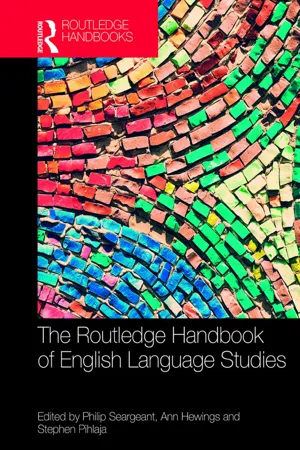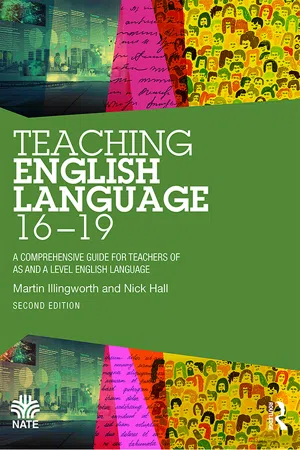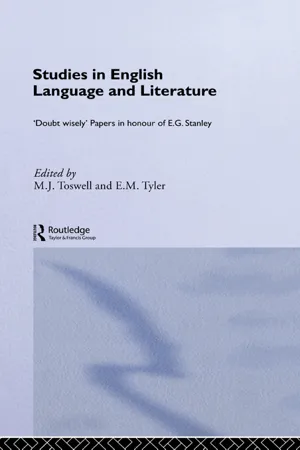Languages & Linguistics
Middle English Examples
Middle English examples refer to written or spoken texts from the period of English language development between the 12th and 15th centuries. This era saw the evolution of English from Old English to the language we recognize today. Middle English examples include works such as Geoffrey Chaucer's "The Canterbury Tales" and the Wycliffe Bible, which showcase the linguistic transition during this time.
Written by Perlego with AI-assistance
Related key terms
Related key terms
1 of 4
Related key terms
1 of 3
4 Key excerpts on "Middle English Examples"
- eBook - ePub
- Ekkehard Konig, Johan van der Auwera(Authors)
- 2013(Publication Date)
- Routledge(Publisher)
5 Old and Middle English Ans van Kemenade 5.1 IntroductionThe terms Old English and Middle English refer to the vernacular language recorded in England in the period from c. AD 600 to c. AD 1500. Old English, or Anglo-Saxon, is the group of dialects imported by the immigrants from the continent in the fourth, fifth and sixth centuries, who drove back the native Romano-Celtic population to Cornwall, Wales and Scotland. The transition to Middle English is usually somewhat artificially marked by the date of the Norman Conquest of England as 1066.For Old English, two main dialect groups are distinguished: West Saxon and Anglian (see Figure 5.1 ). West Saxon is the dialect in which the bulk of Old English manuscript material was written. West Saxon is very poorly documented until the literary activity of King Alfred in the late ninth century. In the literary tradition instigated by Alfred, ‘early West Saxon’ is represented in the Parker manuscript of the Anglo-Saxon Chronicle until 924 and the Alfredian translations of the Orosius and Pope Gregory’s Cura Pastoralis (both c. 900). Late West Saxon is attested in the works of Ælfric, those of Wulfstan, the Abingdon manuscripts of the Anglo-Saxon Chronicle and the A manuscript of the Benedictine Rule. Apart from these, a number of texts that display more dialect mixture are still usually classified as West Saxon: the Old English translations of Bede’s Historia Ecclesiastica, Pope Gregory’s Dialogues and Boethius’ De Consolatione Philosophiae, the Blickling Homilies and the D text of the Anglo-Saxon Chronicle. The Anglian dialect group is subdivided into two: Northumbrian and Mercian. The Northumbrian dialect is identified, above all, by rune inscriptions on Ruthwell Cross and further found in three eighth-century poems (Caedmon’s Hymn, Bede’s Death Song and the Leiden Riddle) and in three extensive tenth-century texts (the glosses on the Lindisfarne Gospels, part of the Rushworth Gospels and the Durham Ritual). In the Mercian dialect from before 900, there are charters from Mercian kings. Further, there is the ninth-century gloss of the Vespasian Psalter, the tenth-century partial gloss of the Rushworth Gospels and some minor glosses. Usually, a fourth Old English dialect is distinguished: Kentish. The material from Kentish is limited to the Kentish Glosses - Philip Seargeant, Ann Hewings, Stephen Pihlaja(Authors)
- 2018(Publication Date)
- Routledge(Publisher)
Another way in which the application of modern linguistic methods has revolutionised the historical study of English is in the field of dialectology. As we saw above, the historical study of English had previously focused heavily on the evolution of the standard language, ignoring the rich evidence for the history of English dialects. This evidence is particularly plentiful in the Middle English period, since there was no standard variety of the written language. For this reason, changes in the methods of historical dialectology in the light of modern approaches are best illustrated by a consideration of the work of the Middle English Dialect Project. This project was instigated by M.L. Samuels and A.I. McIntosh of the universities of Glasgow and Edinburgh respectively, in the 1950s. Drawing on methodological insights from the linguistic survey of the Modern Scots dialects, they set out to produce an atlas of the dialects represented by the Middle English written record. Despite being restricted to exclusively written materials, the Middle English Dialect project proceeded on the assumption that written variation could be subject to dialect mapping in precisely the same manner as had been achieved with spoken differences in the Modern Scots dialect survey. In seeking to apply modern dialectological techniques to the Middle English dialects, the project encountered a number of challenges. An obvious limitation imposed by the sources concerned the lack of access to the spoken language: a problem that affects all historical studies that pre-date the invention of audio recording technology. As well as lacking direct access to the spoken language, the Middle English dialect survey was limited by the lack of localised documents – most Middle English manuscripts were written by anonymous scribes and do not preserve important information about the date or location of their copying. The survey overcame this limitation by developing the ‘fit-technique’; manuscripts were ‘fitted’ on the dialect map by comparing their linguistic forms with those recorded in manuscripts where the location of copying was known (‘localised’ or ‘anchor’ texts) (Benskin 1991). The result of this was the localisation of around 1,000 manuscripts copied in the period between 1350 and 1450, accompanied by extensive linguistic profiles of representative data and schematic maps indicating the distribution of representative linguistic items (McIntosh et al. 1986).- eBook - ePub
Teaching English Language 16-19
A Comprehensive Guide for Teachers of AS and A Level English Language
- Martin Illingworth, Nick Hall(Authors)
- 2018(Publication Date)
- Routledge(Publisher)
As well as these ‘internal’ features of the texts of Old English, you could discuss with your group how they feel about having become detached from the origins of their language. I would suggest that most merely feel that it is mildly irritating not to be able to read texts in museums. It perhaps makes the past feel even more distant and strange. You might reflect with your class upon the plight of languages which are becoming extinct, subsumed by bigger languages like English. For example, the last speaker of the language Kasabe, spoken in Cameroon, died in November of 1996 before the language had been documented by linguists (there are many languages in the world that do not have a written form). It would surely be more than ‘mildly irritating’ if that speaker were a relative of yours and he took with him all of your family history. Languages are the repositories of history, the gateposts to identity and cultural understanding.Middle English Period 1150–1500AD
The Canterbury Tales , Geoffrey Chaucer. Chaucer is an important writer for linguistic study because of the sheer range of voices portrayed in his choice of characters on their pilgrimage to Canterbury from London. Chaucer chose his characters from all walks of life and they bring with them the multiplicity of accents, dialects, high-brow foreign borrowings and earthy Anglo-Saxon vocabulary.The Lord’s Prayer . It can be useful to contrast your Old English version of The Lord’s Prayer (above) with a Middle English version. This makes a good introduction to the ways in which the language has moved on between the two general time periods. Students will undoubtedly note that this text is much more accessible. So, you explore why they can now, not only identify the text, but fully understand it.Oure fadir that art in heuenys, Halewid be thy name. Thy kingdom come to, Be-thy wille don as in heuene an in erthe. Give to us this day oure breed ouer other substaunse, And furgiue to us oure dettouris, And leede us not into temptacioun, But delyuere us from yuel. Amen.Piers Plowman , William Langland. In a period when the English language had made extensive borrowings from French, Langland’s verse is notably lacking in such borrowings. This text deals with the plight of the working classes of the Midlands area and is written in alliterative verse making use of the voice of the peasant classes. For the linguist, this text is a good reminder that each text must be considered on its own merits rather than general notions of what one might expect to see in a text written in 1390.__________________________________This period is dominated by the invasion of the Norman French in 1066. English became a second-, or indeed third-class language in its own country behind the French of the ruling classes and the language of learning and religion, Latin. Writing in English all but disappears after the Norman Conquest until around 1200. English became an oral language, not thought fitting for serious and important matters. - eBook - ePub
Studies in English Language and Literature
Doubt Wisely
- M. J. Toswell, E. M. Tyler(Authors)
- 2012(Publication Date)
- Routledge(Publisher)
As far as the vocabulary is concerned, Old English appears to come to an end in the late tenth and the eleventh centuries, and the Middle English which is documented in texts from the very late twelfth century onwards is in many ways a new language. This gap, however, remains due only to our ignorance, and I will suggest here that a great deal can be learnt about the transitional period in question through looking at what I call very late Old English, namely, the language of twelfth- and, sometimes, early thirteenth-century copies of Old English manuscripts and, occasionally, English glosses found in such manuscripts. In an examination of very late Old English from the point of view of Old English lexicography, E.G. Stanley has called this Transitional English’, 1 while, much earlier and with different emphasis, Arnold Schroer opted for the term ‘neuangelsächsische Periode’: wir haben gleichÆeitig in verschiedenen Gegenden Englands undunter verschiedenen Verhaltnissen auf der einen Seite schon in dieser sogenannten ‘neuangelsachsischen Periode’ eine nationale Schrift-litteratur mit sprachlich-graphischer und stofflicher Tradition, auf der andera Seite noch bis in 13. Jh
Index pages curate the most relevant extracts from our library of academic textbooks. They’ve been created using an in-house natural language model (NLM), each adding context and meaning to key research topics.
Explore more topic indexes
Explore more topic indexes
1 of 6
Explore more topic indexes
1 of 4



